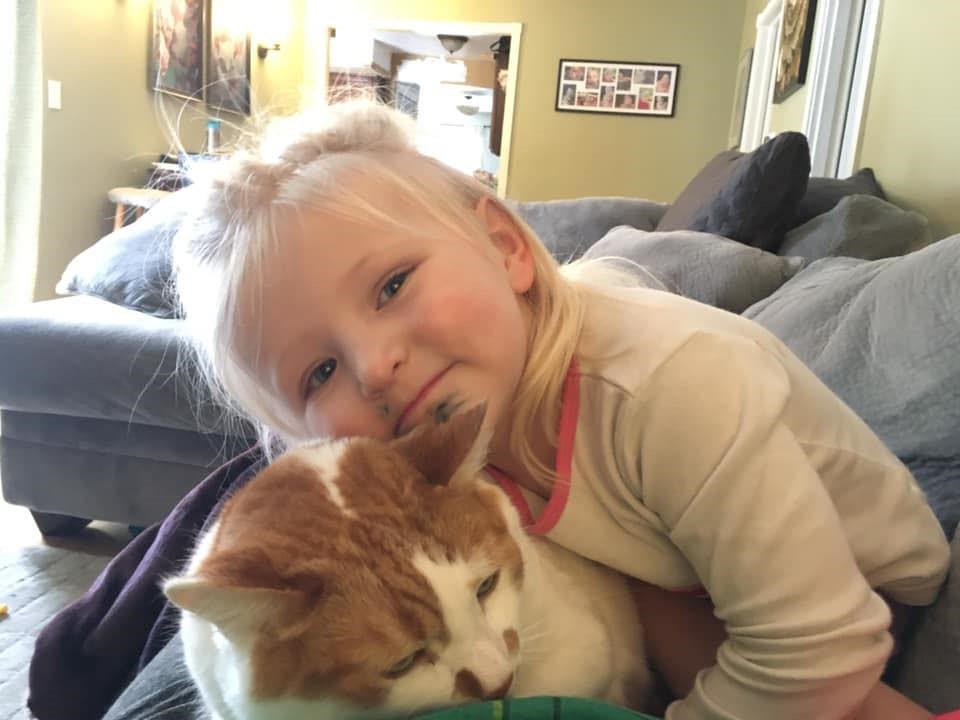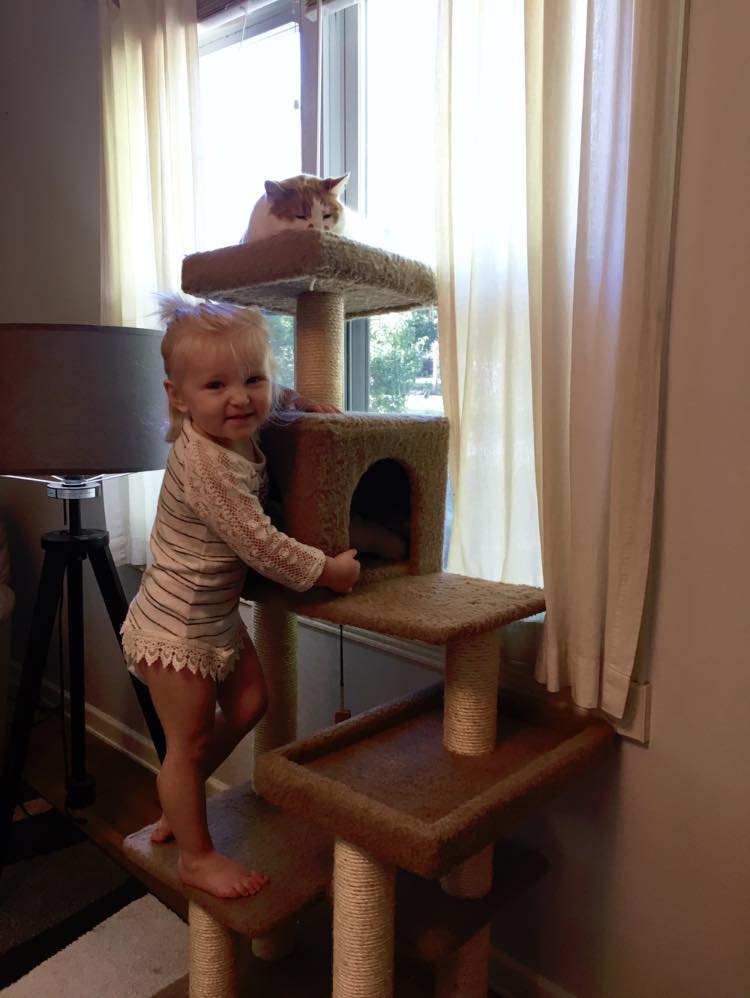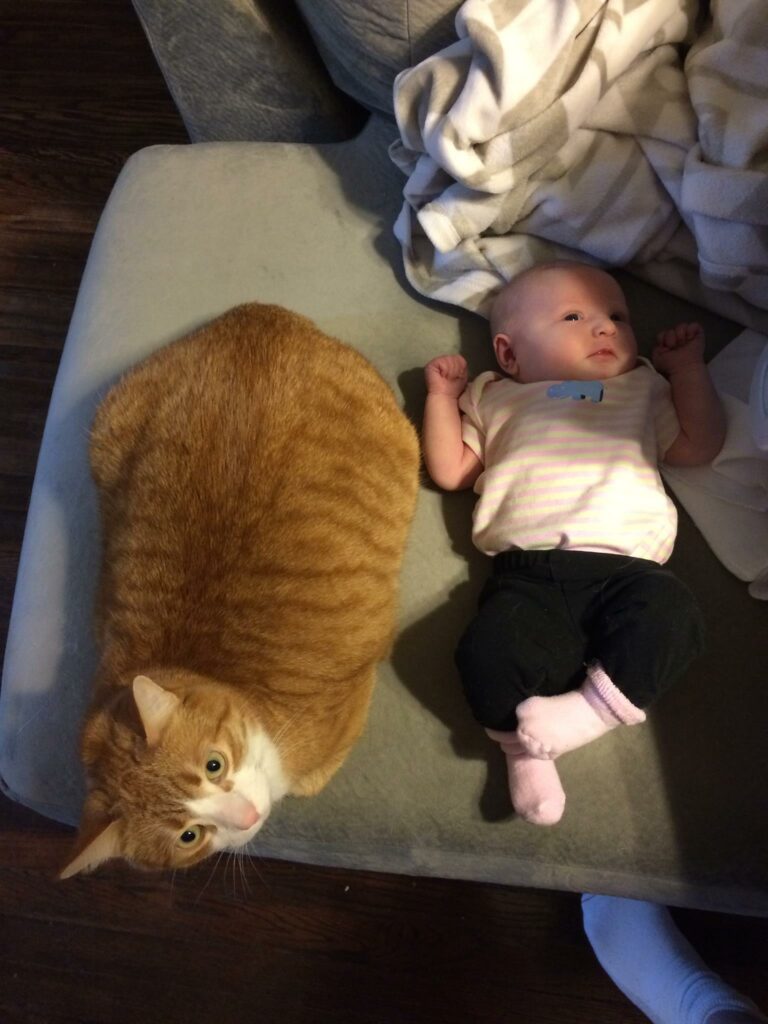This post may contain affiliate links. This means I may receive a small commission if products are purchased through them. All opinions are honest and remain my own.
If you’re wondering are cats good for kids, you should definitely take a couple of minutes to read this. While cats can make a great addition to your family and be wonderful around children, there are definitely things to consider if you’re wanting to bring home a new cat to your kids.
Cats can be wonderful pets for children and help teach responsibility from a young age. However, the truth is, not all cats are good around young kids. Cats are unique, just like people, and have different personalities. According to the Humane Society, cats that are over the age of 2 are best for kids under 6 years old.

Is it safe to have a cat with babies, toddlers, or small children?
For the most part, owning a cat with small kids is safe provided the proper precautions are taken. One of the biggest concerns people bring up is the risk of toxoplasmosis for pregnant women. However, it seems the risks are greatly exaggerated as you’re actually more likely to catch it while gardening or eating contaminated meat or vegetables. You can read more about this in I’m Pregnant, Should I Get Rid of My Cat?!
The biggest issue to keep in mind when considering adopting a feline with small children is the temperament of the cat. Some cats are great with kids – friendly and super laid-back, while others are downright mean or anxiety-ridden.
Waiting till your child is emotionally mature enough to handle having a cat and can understand what is OK and not OK to do with it might be a better call if you’re concerned at all. That age may be different depending on your kid.
However, usually, all it takes is a bad scratch or bite and kids will learn.
Consider adopting a fully-grown cat
Most people want to bring home a new kitten. They’re super cute and you get to watch them grow up alongside your kids. But you should take into consideration the pros and cons of adopting a kitten vs. an older cat. Bringing home a mature cat (even one that’s just 1-2 years old) is a good way to make sure you take one that’s right for your family.
An important point to make is that kittens mature fast, and a feline that’s just 18 months can be fully grown. If you adopt from a shelter, they can oftentimes tell you which felines are safe to take home with children.
My experience with growing up with 3 different kittens – nature vs. nurture
There’s a stereotype about felines that they’re unfriendly, hostile, and reclusive. While some cats are like that, I can tell you that after knowing MANY cats throughout the years that it isn’t true about all of them. They’re all so different!
When I was 6, my mom adopted our family’s first kitten from the Humane Society. My brother named her Lucretia after a Megadeath song. I was so excited to have a pet, but I was disappointed she wasn’t the friendly, cuddly cat I had really wanted. She was very distant, kind of neurotic, and definitely never let me pick her up or wanted me to pet her. She only liked my mom!
A couple of years later, we took in a few stray kittens from my grandma’s farmhouse. They grew up to have different personalities, but they were definitely both more friendly than Lucretia. I still got my share of scratches (from trying to pick them up when they didn’t want to be held) but overall they were docile. One of them, Envy, even let me dress him up in my dolly’s clothing!
Looking back as an adult, this is pretty good evidence that exposing a kitten to children early on does NOT mean it will grow to love kids. I believe their personality is more so written into their genetic code than a factor of their environment.
My experiences makes me really reinforce the suggestion to adopt a fully-grown cat! You really have no idea what the personality of a cat is like until it ages a bit.
What’s the best age for a child to get a cat?
The situation is highly dependent on too many factors to give “an answer”, however, typically slightly older kids will do better around cats. Even the most docile cats aren’t as outgoing as dogs, and most of them don’t like to be chased, prodded, and picked up by young kids.

Still, many cats adjust perfectly fine around kids of all ages.
According to the Humane Society of the United States, if you have young kids under the age of 6, it’s best to take in an adult cat (over the age of 2).
Very young kids, toddlers especially, have a hard time understanding the fact the cats don’t just want to play with them. They chase, grab, pull tails – you name it, they just don’t really “get it” quite yet.
With small kittens, it could be dangerous. You don’t want a toddler grabbing ahold of a kitten and potentially injuring it (kittens are SO tiny and toddlers are not always gentle), nor do you want the kitten scratching or biting your child.
Another good thing about adopting a mature feline when you have small children around is you can actually get to know the cat and their personality before you permanently take them in. Some cats are very docile and friendly and love the attention kids will give them, but it can cause massive stress and anxiety in some cats.
And just to be clear, I am saying all this from personal experience. I adopted my 2 cats from the Humane Society before I had any kids. I didn’t give any thought to children around because I wasn’t planning on having any at the time.
However, now that my daughter is almost 3 one of my cats Charlie is not doing well with her around. He’s very anxious, stressed, scared, and hides a lot now. Every time he sees her, he runs. This isn’t even due to her trying to pick him up or pull his tail or anything (he will never let her close enough) it’s simply just from her being her. You know, running around, being loud, being unpredictable. Sudden movements. Little kid stuff. The other cat, Louie, is just fine.
If I had adopted cats AFTER I had children, I would definitely make sure the cats were OK with small kids.
Benefits of kids growing up with cats
Growing up in a household with cats can have many advantages for children.

Teaches responsibility
Having a pet like a cat is actually great for development. It gives children a sense of the responsibility that comes with caring for another living creature (which is really true for any pet).
Depending on the child’s age, they could help with tasks such as feeding, scooping/cleaning litter boxes, grooming, and even cleaning up accidents or hairballs. Not only will it lessen your chore-load, but it is also a great teaching tool for them!
Currently, my daughter is only 3, but she LOVES to feed the cats. She gets so excited every time and always asks, “can I feed the cats now?” It makes her feel like a “big girl” and it’s a responsibility that she can handle. As she gets older, I will let her help more.
Love and friendship
Having a furry companion can be a great comfort to a child. I remember growing up how much joy and affection my kitties brought me. It made me feel safe when they purred next to me in bed at night. They’re also fun to play with and a great source of entertainment!
It’s also a friendship without arguments, judgment, or back-talk.
Reduced allergies
Lastly, it’s also been shown in certain studies that growing up around cats or dogs can actually reduce the likelihood of allergies. The greater the number of pets, the more protection against allergies! So go ahead and get multiple cats, just not too many! 😉
Risks of cats in the home
Bites and scratches – cat bites and scratches can actually be pretty serious since cats’ teeth are very sharp and can penetrate deep into the skin, introducing bacteria straight into the bloodstream. It’s important to clean cat wounds very thoroughly and watch for any possible signs of infection. This is more dangerous with outdoor cats vs indoor ones.
Allergies/Asthma trigger – while growing with cats can reduce a child’s risk of allergies throughout their life, it doesn’t mean they won’t be allergic to cats. Cat hair and dander can also trigger asthma attacks in some people.
Infections/Parasites – certain infections like Toxoplasmosis or Cat Scratch Fever can be transmitted from cats to humans, but serious symptoms/complications are rare in both cases. Toxoplasmosis is only a concern for pregnant women (or immunocompromised).
Keeping the peace between kids and cats
If you find yourself in a situation where you have a child and cat that aren’t peacefully co-existing, some boundaries need to be set. This is much, much more difficult in toddlers as their little brains are still developing.
- Depending on the age, reinforce “NO”, or redirect unwanted behavior like chasing, pulling tails, or trying to grab the cat when it’s unwelcome.
- Make sure your small kids are properly supervised around the cat
- If you can, just keep the cat away from the child as much as possible until they’re old enough to know better than to tease and torment them. (If they have adequate space and hiding, cats can actually do a pretty good job of keeping themselves away without much help)
The older the kid, the easier it will be to teach them to understand what type of behavior the cat will and will not tolerate.
The Bottom Line
Overall, many cats can adjust to being around children just fine. Cats may not be as friendly and outgoing as most dogs, but they can still make great companions for children.

Leave a Reply